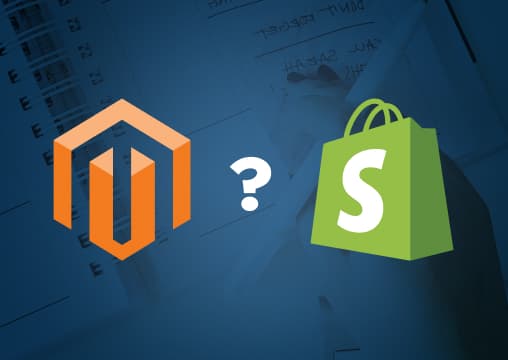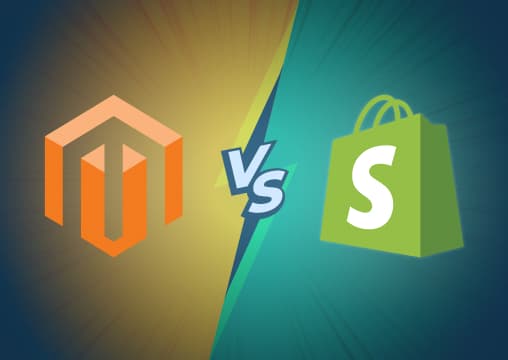
Magento to Shopify Migration Cost
Let’s face it: price has a very important part to play in most of our purchases. The larger the costs, the more we worry about payment.
MTN Haus has been on both sides of this price conversation. We’ve asked our partners how much their services are going to cost countless times, and in turn, we’ve been questioned about the pricing of our services, too.
But the one particular service that results in the largest number of questions for us? Magento to Shopify migration costs. Ever since the emergence of Shopify, relocation from one platform to another has been quite high.
And with the rise of Shopify, more and more people are interested in learning about the aspects of setting up a Shopify store. Pricing, among other things, is an important “need to know” aspect — so that’s what this piece is about.
In this article, we’ll discuss how much it costs to migrate from Magento to Shopify, to set up a Shopify store, Shopify’s plans and pricing options, and how much its themes and integrations may end up costing.
So, with the stage now set, let’s explore Magento to Shopify migration costs!
hy do people prefer Shopify instead of Magento?

Before we discuss Magento to Shopify transfer cost, let’s take a quick glance at all the possible reasons why users might want to shift to the latter platform. For one, Shopify is extremely easy to use (especially when compared to Magento). We’re not just talking about overall accessibility, but it’s also much easier to set up and get everything started.
For example, if users wish to set up a store on Magento, they’d need to learn how to code (or hire a web developer to get the task done for them). But, if they wish to set up a store on Shopify, all they’d have to do is make an account and select themes.
Shopify also provides its users with more features. Sure, Magento may rank higher in customizability, but Shopify has some pretty great sales tools, such as cart recovery, allowing sale of digital and physical products, selling on multiple channels, and partnerships with delivery platforms like Canada Post, USPS, DHL Express, and more.
Sales tools are not the only category that Shopify wins in — it also has impressive marketing tools (such as third party integrations with thousands of apps, sellers being able to advertise directly on social media, and users getting to access the site via multiple languages).
Magento doesn’t have a mobile app, which can be a bummer. Plus, it also lacks first-party POS systems, free subdomains, blogs, unlimited bandwidth, PCI-DSS compliance, free SSL certificate, and detailed sales reports. Conversely, Shopify provides all these features. Oh, and it’s also difficult to find a hosting provider for Magento.
So, all in all, this makes for a pretty compelling case as to why users should opt for Shopify over Magento.
Migration stages
Stage 1: Create a data backup
First things first — before we even begin discussing the migration process, we must ensure that we have all our data stored, secured, and backed up so that there are no issues later on. So, how does one create a data backup on Magento, you ask? Well, your hosting provider may already provide automatic backups. But to err on the side of caution, here’s what you should do:
- Once you’re on Magento, click on Admin > System > Tools > Backup.
- Take your pick between “Systems Backup,” “Database Backup,” or “Database and Media Backup.”
- Add a name to your file and select the button that says “OK.”
Stage 2: Create a Shopify store
If you haven’t already, now is the time to create a Shopify store. Shopify offers four plans:
- Basic
- Advanced
- Shopify
- Shopify Plus
Once you decide which plan you want, you’ll then have to answer a few simple questions about your intentions with the site and how you plan to operate your business.
Alternatively, if you wish to test out the plans to see which tickles your fancy, you can opt for a free trial.
Stage 3: Decide if you want to migrate manually or use the store app
This is a pretty crucial step. You can either migrate all your data to Shopify manually or automatically (aka, by using the store app). If you wish to migrate automatically, you’ll need to download apps like Import Store, Multichannel Importer, or Excelify.
If you wish to migrate data manually, then you can opt for either copy-pasting all data or using CSV files to make the job a little easier for yourself.
Once you’ve made the choice between manual migration or app-based migration, go to Magento and select Admin > System > Data Transfer > Export.
A pop-up box will open up where you’ll need to decide between the options “products,” “customer main file,” or “customer address.”
The next step is to decide on the file format, so click on XML if you want automatic migration or click on CSV if you want manual migration.
Stage 4: Transfer your data and review everything
Congratulations on completing all the above steps! You can now commence the task of manually migrating your data (if that’s what you opted for) or you can complete the process of automatically migrating your data by going to Shopify and selecting Apps > Import Store > Magento > Upload Files > Add Files > Continue Import > Import.
In both cases, once you’re done, take a moment to take a look at your handiwork to ensure that no important data or files are missing and everything is exactly where it ought to be.
Stage 5: Set up the store
Now comes the part of branding your business. Setting up a store on Shopify should be relatively easy — after all, all the themes are already in place (plus, they’re all mobile-friendly!). There are a total of ten free themes available in the store.
Side note: They have paid themes, too, that might cost upwards of $180.
Aside from just setting up the themes, ensure that you set up other processes of your business too, such as payment, shipping, and the transfer of your domain address.
Stage 6: Test it out
To ensure that everything is nice and neat, we recommend that you try out your site to see if it’s fit for your customers’ use. The ideal activities to do are to browse the site to see if the UX is looking good, if products have ample descriptions, and if everything is easy to access. Aside from that, you should also try to set and cancel orders as well as initiating both making payments and canceling them.
For more information on how to migrate from Magento to Shopify, click here on our blog that explains the migration process in detail.
What do you get with us?
1. You save time and costs
There are two ways you can go about migrating to Shopify. Option A: You can do it yourself. Option B: You can hire experts. Now, if you go with option A and let your in-house team do the work of migration, then you will have to jump through the hoops of trial-and-error to ensure that everything is in the correct order, no information is lost, no human error is made, etc.
While all these are important aspects of migration, nailing them to perfection is not a task that can be done correctly in one go (since it takes multiple passes to review the information, run the demo launch to see if the product is running without any issues, and ensure the site looks well developed).
The experts have years of experience in doing tasks like these, so they end up doing a better job (at a faster pace) and reduce the margin of error.
Say you still want to continue to hand over the task to your in-house team. Then consider the timeline your project will take, because the longer your process draws out, the more time it’s going to take from your team members, which means they’ll end up lagging behind on work-related tasks.
So, to give your team the time to do their work, not have any downtime, and get the systems up and running, it’s a good idea to hire the experts.
2. You have a better end product
New users of Shopify might have a limited understanding of the platform and might not be able to reap all the benefits of the platform. Since we’re Shopify partners, we know the platform inside and out.
So, once we understand your project requirements, we can assist you and your team members set up and ensure that all the necessary systems, automations, and integrations are in place. Doing so will help you eliminate busy work and give you more time to do the important tasks at hand.
Alongside this, we also have a team of professional designers onboard who can help you develop your Shopify website to make it more appealing and eye-catching for the end user (thus ensuring more sales for you).
Trust us, MTN Haus is not just a service provider — rather, once we shake hands on it, we’re your business partners who will help you achieve the best version of your vision.
3. No information is lost
Ensuring all mission critical data is in one place is a very important aspect of migration — and at MTN Haus, we migrate data in such a way that no data of yours is lost. This means that all customer information, product data, old content, images, graphics, posts, blogs, descriptions, customer addresses, and all the other information you need to continue doing business as usual will be transferred onto your new platform.
4. We have the necessary experience
The team at MTN Haus has more than 10+ years of experience helping clients migrate between the two platforms (and has also assisted with migrations from other platforms like NetSuite, WooCommerce, and BigCommerce). We’re also a Shopify Plus partner and have helped hundreds of brands (like Sleeping Baby, BotNot, Vinia, etc.) help achieve their goals.
Magento to Shopify Migration Cost
Let’s consider costs in three ways:
- Shopify platform fee
- Themes and apps
- Migrating and setting up the site
1. Shopify platform fee
Shopify has three plans available on its website: Basic (available for $29/month), Shopify (available at $79/month), and Advanced (available at $299/month). Users may save up to 10% on these prices if they select the yearly membership. Shopify Plus is another option they can opt for, which is available starting at $2000/month.
2. Themes and apps
Shopify has free themes for its users. However, they have premium themes available too, which generally cost between $180 – $350. The platform also has over 6000+ apps for the convenience of its users, but those too may range from free to premium costs (however, most apps on the platform end up costing around $20/month).
3. Migrating and setting up your site
The price of migrating from Magento to Shopify may land anywhere from $500 to upwards of $42,000 per project. The cost of setting up a Shopify site could be anywhere between $100 and $27,000. Alternatively, some team members may charge around $50 – $80 or more per hour. Ultimately, it all depends on the niche you operate in, the kind of site you want, how long the process is, how large the site is, and how experienced your experts are.
At MTN Haus, we base pricing on many factors, but what it essentially boils down to is individual pricing based on individual needs instead of making users pay extra for the services they neither want nor require.
Transfer Magento store to Shopify store price — side note
All prices mentioned here were sourced during the time of writing and may change depending on many factors. MTN Haus may edit these articles to reflect the current prices.
Conclusion
Alright, that concludes our article! If you’re ready to move forward with Magento to Shopify migration at an affordable rate, done by experts who are Shopify partners, pros who will not only help migrate and set up your site, but will also remove the possibility of any data leaks and human errors, then get in touch with MTN Haus — we’re always here to lend a helping hand!




